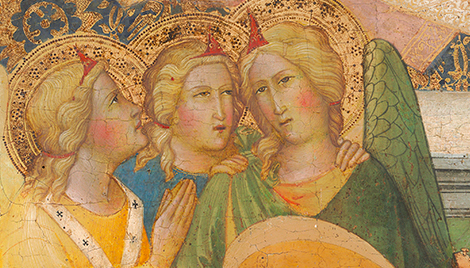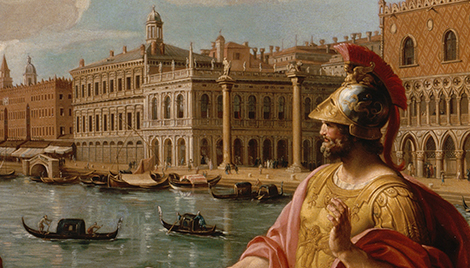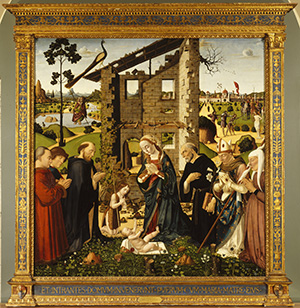The Adoration of the Child with Saints and Donors
The Adoration of the Child with Saints and Donors
- Artist
- Biagio d'Antonio
- Artist Dates
- c. 1446-1516
- Artist Nationality
- Italian
- Title
- The Adoration of the Child with Saints and Donors
- Date
- c. 1476
- Medium
- tempera on panel
- Dimensions
- 185.4 x 181 cm (73 x 71-1/4 in)
- K Number
- K1088
- Repository
- Philbrook Museum of Art
- Accession Number
- 1961.9.19
- Notes
Provenance
Commissioned by Niccolo Ragnoli for the Church of San Michele, Faenza, until c. 1805. [1] Marchese Filippo Hercolani, Bologna, from c. 1805. Rev. William Stogdon, Harrow-on-the-Hill, Middlesex, by 1905. [2] (Arthur Tooth & Sons, London); sold 1917 to (Duveen Brothers, Inc., Paris and New York); [3] Carl W. Hamilton, [1886-1967] New York, in 1922. [4] (Duveen Brothers, Inc., New York, as Giovan Battista Utili) by 1930; [5] sold to Samuel H. Kress [1863-1955] in 1937; gift 1939 to the National Gallery of Art; deaccessioned in 1952 and returned to the Samuel H. Kress Foundation; gift 1961 to Philbrook Museum of Art, Tulsa, no. 1961.9.19. [1] Listed in the 1682 and 1685 inventories of the church; noted as sold in the 1805 inventory. [2] Published by Roger Fry, "On a Florentine picture of the Nativity," Burlington Magazine VII (1905): 70, repro., as Stogdon collection. Not included in the 1922 Christie's London sale of John Stogden of the same address. [3] Duveen "X-Book," Duveen Brothers Records, Getty Research Institute, Los Angeles, no. 960015, Microfilm Reel 422, Folio 80. [4] Hamilton acquired many of his paintings from Duveen on credit; he returned many of the Duveen paintings in May 1921, and most of the other paintings seem to have made their way back to the dealers who had sold them to Hamilton. [5] Shipped from Duveen Paris to New York, 14 May 1930, Consular Invoices 1929-1930, Duveen Brothers Records, Getty Research Institute, Los Angeles, no. 960015, Box 136 Folder 3.
Catalogue Entry
Biagio d'Antonio
The Adoration of the Child with Saints and Donors
K1088
Tulsa, Okla., Philbrook Art Center (3361), since 1953.(1) Wood. 73 X 71 1/4 in. (185.4 X 181 cm.). Fair condition except for damaged and restored face of the female donor at extreme right; should be transferred because of extensive worm tunneling in the wood. Formerly attributed to Utili,(2) the painting is discussed in four documents, dated 1682, 1695, 180(?), and 1805.(3) Those of 1682 and 1695 are inventories which describe K1088 in unmistakable detail and prove that it was in those years still on the high altar of the parochial Church of San Michele, Faenza, for which it was surely painted, since it had a crowning piece (probably a lunette, now lost) which represented the church's titular saint, Michael, driving away the demons. Its original frame (now missing) is also described, as decorated with blue and gilded carving. The documents of 180(?) and 1805 are letters which again describe the painting; they show that it came from the Church of San Michele but had been bought by Marchese Filippo Hercolani, writer of the letters, who states further that the painting had been commissioned by the Ragnoli family. This last statement is supported by the fact that the church had been built and furnished by the noble Faentine Nicolo Ragnoli, who lived in a house opposite the church. Hercolani also writes that the painting is dated 1470. Although there is no trace of a date on K1088 to confirm or disprove this, 1470 is believed to be a misreading of 1476, since the church was finished about this time and since a notarial document of June 1476 records the presence in the house of Nicolo Ragnoli of two painters as witnesses, one of whom was Biagio d'Antonio, who was then living in the parish of San Michele.(4) That K1088 is by Biagio d' Antonio is proven by its identity of style with two paintings now in the Faenza Pinacoteca convincingly shown to have been commissioned of him, one in 1483, the triptych 'di Pergola'; the other in 1504, the Madonna with Sts. John the Evangelist and Anthony of Padua.(5) In K1088 Nicolo Ragnoli is undoubtedly to be recognized in the donor kneeling at the left, probably with his son and the son's patron saint (Dominic?), along with the Infant John the Baptist; opposite the donor are his wife with St. Louis of Toulouse and the donor's patron saint, Nicholas of Tolentino. In the middle distance are St. Christopher and the martyrdom of St. Sebastian, while in the further distance is a river valley and the walled city of Florence, in which the Palazzo Vecchio, the Duomo, the Campanile, the Baptistery, and the tower of Santa Maria Novella are clearly recognizable. The flowering plants in the foreground admit of identification.(6) Provenance: Church of San Michele, Faenza (until c. 1805). Marchese Filippo Hercolani, Bologna (from c. 1805). Rev. William Stogdon, Harrow-on-the-Hill, Middlesex (as early as 1905). Carl W. Hamilton, New York (1922). Duveen's, New York (Duveen Pictures in Public Collections of America, 1941, no. 116, as Utili) – exhibited: 'Italian Art,' Royal Academy, London, Jan. 1-Mar. 8, 1930;(7) 'Italian Paintings of the XIV to XVI Century,' Detroit Institute of Arts, Mar. 8-30, 1933, no. 39, as Utili. Kress acquisition, 1937– exhibited: National Gallery of Art, Washington, D.C. (456), 1941-52;(8) after entering the Philbrook Art Center: 'Art Treasures for America,' National Gallery of Art, Washington, D.C., Dec. 10, 1961-Feb. 4,1962, no. 9, as Biagio d' Antonio da Firenze.
References
(1) Catalogue by W. E. Suida, 1953, pp. 42 ff., as Biagio d'Antonio da Firenze. (2) K1088 has been attributed to the Florentine School by R. Fry (in Burlington Magazine, vol. VII, 1905, pp. 70 f); to 'Compagno di Botticini' by E. Kühnel (Francesco Botticini, 1906, p. 19); to Utili by B. Berenson (Catalogue of Johnson Collection, Philadelphia, Italian Paintings, vol. I, 1913, p. 36; Italian Pictures ... Florentine School, vol. I, 1963, p. 209, where he tentatively accepts the Biagio d' Antonio identification), R. van Marle (Italian Schools of Painting, vol. XIII, 193 I, p. 169), G. Fiocco, and A. Venturi (in ms. opinions); to Biagio d'Antonio by R. Longhi and F. M. Perkins (in ms. opinions; see also note 1, above); to Benedetto Ghirlandaio by G. de Francovich (in Dedalo, vol. VI, 1926, p. 724). (3) Published by E. Golfieri and A. Corbara, pp. 3 ff. of reprint cited in note 1, above. (4) Ibid. (5) C. Grigioni, Pittura faentina, 1935, p. 209; and A. Sorrentino, in Bollettino d'Arte, vol. xxxv, 1950, pp. 185 f (6) They are identified in The Herbarist (Boston), 1943, p. 4. (7) Listed as Utili da Faenza (in Art News, Dec. 28, 1929, p. 4) among the paintings sent to the exhibition; but it is not included in the catalogue. (8) Preliminary Catalogue, 1941, p. 205, as Utili.






